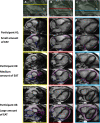Epicardial adipose tissue and subclinical incident atrial fibrillation as detected by continuous monitoring: a cardiac magnetic resonance imaging study
- PMID: 38245893
- PMCID: PMC10951027
- DOI: 10.1007/s10554-023-03029-z
Epicardial adipose tissue and subclinical incident atrial fibrillation as detected by continuous monitoring: a cardiac magnetic resonance imaging study
Abstract
Epicardial adipose tissue (EAT) has endocrine and paracrine functions and has been associated with metabolic and cardiovascular disease. This study aimed to investigate the association between EAT, determined by cardiac magnetic resonance imaging (CMR), and incident atrial fibrillation (AF) following long-term continuous heart rhythm monitoring by implantable loop recorder (ILR). This study is a sub-study of the LOOP study. In total, 203 participants without a history of AF received an ILR and underwent advanced CMR. All participants were at least 70 years of age at inclusion and had at least one of the following conditions: hypertension, diabetes, previous stroke, or heart failure. Volumetric measurements of atrial- and ventricular EAT were derived from CMR and the time to incident AF was subsequently determined. A total of 78 participants (38%) were diagnosed with subclinical AF during a median of 40 (37-42) months of continuous monitoring. In multivariable Cox regression analyses adjusted for age, sex, and various comorbidities, we found EAT indexed to body surface area to be independently associated with the time to AF with hazard ratios (95% confidence intervals) up to 2.93 (1.36-6.34); p = 0.01 when analyzing the risk of new-onset AF episodes lasting ≥ 24 h. Atrial EAT assessed by volumetric measurements on CMR images was significantly associated with the incident AF episodes as detected by ILR.
Keywords: Atrial fibrillation; Cardiac magnetic resonance; Epicardial adipose tissue.
© 2024. The Author(s).
Conflict of interest statement
JHS is a member of Medtronic advisory boards and has received speaker honoraria and research grants from Medtronic in relation to this work and outside the submitted work. SZD is a part-time employee of Vital Beats and has received speaker fees from Pfizer and advisory honoraria from Bristol-Myers Squibb outside the submitted work. AB reports research grants from The Region of Southern Denmark and The Region of Zealand, and Theravance; speaker honoraria from Bayer, Boehringer Ingelheim, and Bristol-Myers Squibb; and a travel grant from Biotronik, outside the submitted work. LK reports speaker honoraria from Novo, AstraZeneca, Novartis, and Boehringer Ingelheim, outside the submitted work. All other authors declare no competing interests.
Figures


References
-
- Hindricks G, et al. 2020 ESC Guidelines for the diagnosis and management of atrial fibrillation developed in collaboration with the European Association for Cardio-Thoracic Surgery (EACTS): the task force for the diagnosis and management of atrial fibrillation of the Europea. Eur Heart J. 2021;42(5):373–498. doi: 10.1093/EURHEARTJ/EHAA612. - DOI - PubMed
MeSH terms
Grants and funding
LinkOut - more resources
Full Text Sources
Medical

